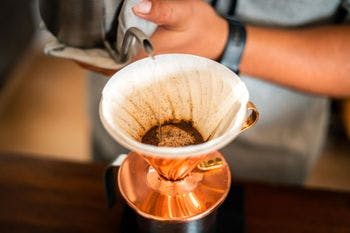
What is Coffee Torrefaction? (Detailed Explanation)

Are you someone who begins their day with the rich, invigorating aroma of freshly brewed coffee? If yes, you must be familiar with the magical process that transforms simple coffee beans into the aromatic beauty we all adore: torrefaction.
If not, don't worry! Today in this blog I will share with you the complete insights about coffee torrefaction. So stay with me till the end.
What is coffee torrefaction?
Coffee torrefaction is a thermal process where the beans acquire their brown color from green. In this process, the sugar is added while roasting which caramelizes and coats the beans.
During roasting, you will observe that the weight is reduced by 16%, the volume is doubled and the essential oils from the coffee beans are released.
Benefits of torrefaction
1) Enhanced flavors
Do you know torrefaction can make your ordinary beans extraordinary by extracting the complete flavors from coffee beans? The roasting process develops complex tastes, creating a rich and enjoyable drinking experience.
2) Aromatic delight
The torrefaction process releases aromatic compounds contributing to the enticing scent we experience within a perfect cup.
3) Better shelf life
Roasting works as a natural preservative reducing the moisture content in beans. With the moisture reduction, the shelf life of beans extends, ensuring freshness and quality for a longer period.
4) Customized flavor profile
Roasting is customizable as per coffee preference to achieve specific flavor profiles. Whether it's a light and fruity roast or a dark and robust one, torrefaction provides a wide range of customization to serve diverse taste preferences.
5) Caffeine adjustment
The roasting process can adversely affect caffeine levels. While it's a common belief that dark roasts have more caffeine, the reality is a little out of the box. Caffeine levels may vary depending on the roasting duration, providing options for those seeking a milder or full-bodied cup.
6) Consistent quality
Torrefaction allows for consistent quality in coffee production. Roasters can fine-tune the process to ensure that each batch meets the set standards, providing a reliable and flavorful coffee experience.
Downside of torrefied coffee
1) Loss of original bean characteristics
Excess heat can overpower the subtle floral, citrusy, or tea-like notes observed in some green beans, homogenizing the flavor profile.
2) Reduced caffeine content
Contrary to the belief that dark roasts have more caffeine, the roasting process can decrease caffeine levels. Those preferring a higher caffeine intake must opt for lighter roasts.
3) Potential for bitterness
Over-roasting or extended exposure to high temperatures can lead to a bitter-tasting coffee. Finding the right balance in roasting is essential to avoid overpowering bitterness that might not be appreciated by all coffee enthusiasts.
4) Potential for Acrylamide Formation
Roasting coffee at high temperatures can harm coffee lovers with the formation of acrylamide. It's a chemical compound that forms when certain food items are cooked at very high temperatures. While the levels of it in coffee are generally low, it is a crucial point to consider.
5) Higher processing costs
The specialized equipment and energy requirements for torrefaction can lead to a higher processing cost for consumers.
Stages of coffee torrefaction
1) Choose the right beans
It begins with picking the best green coffee beans. If you are thinking, does the kind of bean and where it's from affect the coffee's taste? Then let me tell you that, yes it does.
2) Heat the beans
Place the green beans into a hot roasting machine (like an oven) and set the temperature between 350°F to 500°F.
3) Dry the beans
The beans will lose their moisture here. You can think of it as a warm-up for the next steps.
4) You will hear a cracking sound
When things get hot, the beans make a popping sound called the "first crack." It is a sign that the beans are changing inside.
5) The magical reaction
Now what turns the beans brown? Well, it's the Maillard reaction. In this reaction, the amino acids mix with sugars, creating different flavors and making the beans turn brown.
6) Break down of flavors
More reactions happen, adding different tastes to the coffee. Sugars caramelize, acids break down – it's like a flavor burst!
7) Let the beans cool
Once the beans look just right, cool them down. It will stop them from cooking too much and ruining the flavors.
8) Keep beans aside for a while
Some coffee roasters let the beans sit for a little longer for the flavors to shine after roasting.
Taste profile of Torrefacto coffee
1) Bittersweet notes
One of the remarkable features of Torrefacto coffee is its bittersweet taste profile. The roasting process includes adding a small amount of sugar to the beans which results in a distinctive combination of bitter undertones and a subtle sweetness.
2) Bold and intense aroma
Torrefacto coffee is well-known for its intense and bold aroma. The roasting method improves the aromatic compounds, creating a captivating fragrance that adds to the overall experience.
3) Reduced acidity
Torrefacto roasting mellows the acidity of the coffee. For those who prefer a bright flavor profile, Torrefacto coffee provides a smoother and more rounded taste.
4) Hints of caramelization
The addition of sugar during roasting leads to caramelization, imparting subtle caramel notes to the coffee. This sweetness complements the boldness of the brew.
Wrapping up
That's all for this blog. I hope now you know everything about coffee torrefaction. So the next time someone asks you about your secret ingredient for the perfect coffee, share this with them and flaunt your coffee knowledge.
Whether it's a miss or match will be a personal decision of the consumer as the coffee lovers that like it to be a bit sweet will definitely adore it. While others might not find it that satisfying if you are a concentrated espresso lover.
So wear your barista hat, get your ingredients, and try this in your next recipe. Also, share your views in the comments section.

I am a barista by profession hailing from NC. My journey began in my late teens when I started working as a barista in a local coffee shop. My passion for coffee quickly became evident as I immersed myself in the art of espresso extraction, latte art ...


